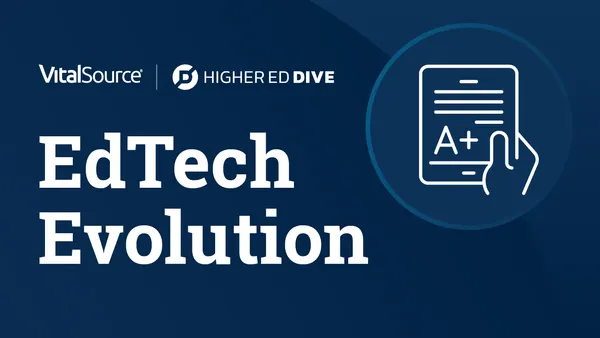The rise of artificial intelligence (AI) tools, and the ability for students to have increased access to the tools, has caused educational institutions to rethink ways to ensure academic integrity. Some institutions (and even countries) have banned generative AI tools, like ChatGPT, while others have embraced the implementation to expand student learning. Stakeholders along the educational hierarchy from students to employers expect assessments to drive the curriculum and the outcome of those assessments to signify competence in the learning process. As these two worlds converge, educators are left wondering, “How do I ensure academic integrity in an AI world?”
No matter what side of the AI debate you’re on, one thing remains clear and even more important than ever … Now is the time to redefine assessment practices to ensure learning is engaging, measurable, and relevant so students are competent and confident.

Designing assessments to be authentic requires educators to reframe their thinking about what signifies competence in a topic. Does a passing score on a multiple-choice exam demonstrate that a nurse can perform their duties in an emergency? We know that answer is “no,” but how can the assessment process be refined? That’s where authenticity makes the difference.
The explosion of AI has pushed educational institutions to reconsider how to design authentic assessments. And although it is being discussed quite heavily today, authenticity in assessment isn’t new to education. The term, authentic assessment, was coined by Grant Wiggins in 1998. Wiggins defined authentic assessment as: realistic, requiring judgment and innovation, asking the student to “do,” replicating or simulating real life, assessing the student’s ability to efficiently and effectively use knowledge and skills to negotiate a complex task, and allowing opportunities to rehearse, practice, integrate feedback, and refine the final product.
Educators are familiar with traditional assessment tools such as multiple-choice or essay exams, technical writing, case studies, end-of-term papers or project submissions, and student presentations. And, for over 20 years, education has been trying to create technology that detects cheating and plagiarism and verifies the student’s identity. Eliminating cheating was a challenge before the explosion of AI-technology. Now, institutions are quickly pivoting to redefine assessment strategies that accurately measure skills and learning, while actively engaging students.
How can institutions ensure their students are ready for the next phase of their journey? One solution is utilizing video-based assessment software to design authentic assessments that provide learners with enhanced opportunities for practice, demonstration, and feedback through video.
All stakeholders can benefit from the incorporation of video in any type of assessment. Here are the top four advantages:
- Video-based assessment provides learners with the opportunity to practice and self-reflect. Learning through practice and self-reflection has proven to increase the likelihood of memory permanence, automaticity, increased ability to transfer practiced skills to new or more complex problems, increased expertise in the subject matter, and cognitive gains that increase motivation for learning. By allowing students to review their video assignment prior to submission, inherently, the student begins the process of self-reflection.
- Video-based assessment allows learners to collaborate with their peers. Peer grading/feedback “enables students to assess themselves, as well as exposing them to different ways of approaching a task.” Peer grading enables students to view their peer’s work while providing detailed feedback on their perceptions. This enables students to gain valuable learnings of their own along the way. Peer grading can also be done in a group where students can discuss feedback and increase their own knowledge base on the subject.
- Video-based assessment provides efficiencies for educators. Incorporating video-based assessments allows teacher grading and feedback to be quicker, more detailed, and include more actionable feedback for students. By using video-based assessment for hands-on, or clinical assessment, institutions can see a cost-savings as faculty are able to limit onsite observations and the time it takes to provide feedback to each student. In addition, using video-based software helps faculty spend less time grading by utilizing a scalable system with custom rubrics. This software allows faculty to create custom rubrics, build assessment libraries, integrate with LMS platforms, and record or grade video evidence from anywhere.
- Video-based assessment enhances student learning and graduates professionals who are ready to work. Employers want graduates who can solve problems and apply knowledge quickly and confidently. Video-based assessment and feedback allow students to continue the learning process even after completing the assessment.
Using video-based assessment to improve educational practice has benefits for all assessment stakeholders. Graduating students who have demonstrated the ability to problem-solve, critically think, and display competence within their skillset builds the institution's reputation and that of the programs within it. Faculty are bombarded with demands to redefine what competence means and continue to look for ways to efficiently grade student work and ensure the security and authenticity of the work submitted.
Institutions recognize that the most important stakeholder in the education process is the student. Students are demanding education that breaks away from the traditional brick-and-mortar lecture-based environment of the past. Video-based technology bolsters authentic assessments and creates more meaningful learning experiences that inevitably drive higher learning outcomes. Designing authentic assessments that ensure the right student is taking the right assessment ultimately graduates students with stronger skill sets for employers.










